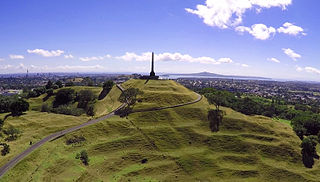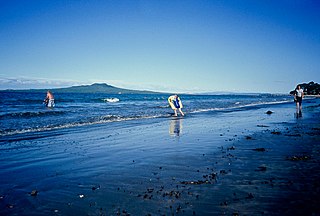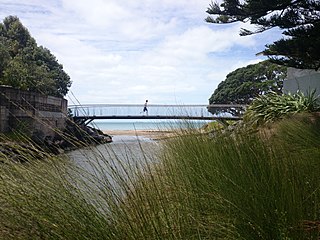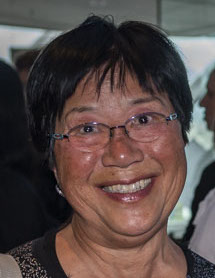Related Research Articles

Maungakiekie / One Tree Hill is a 182-metre (597 ft) volcanic peak and Tūpuna Maunga in Auckland, New Zealand. It is an important place culturally and archeologically for both Māori and Pākehā. The suburb around the base of the hill is also called One Tree Hill. It is surrounded by the suburbs of Royal Oak to the west, and clockwise, Epsom, Greenlane, Oranga, and Onehunga. The summit provides views across the Auckland area, and allows visitors to see both of Auckland's harbours.

Epsom is a suburb of Auckland, New Zealand. It is located in the centre of the Auckland isthmus between Mount Eden and Greenlane, south of Newmarket, and 5 km (3.1 mi) south of the Auckland City Centre.

Sir John Logan Campbell was a Scottish-born New Zealand public figure. He was described by his contemporaries as "the father of Auckland".

The Northland Peninsula, called the North Auckland Peninsula in earlier times, is in the far north of the North Island of New Zealand. It is joined to the rest of the island by the Auckland isthmus, a narrow piece of land between the Waitematā Harbour and the Manukau Harbour in the middle of the Auckland metropolitan area. The peninsula is not conterminous with the local government area of Northland Region, which occupies the northern 80% of the peninsula, as the southern section is administratively part of the Auckland Region.

Panmure is an east Auckland suburb, in the North Island of New Zealand. It is located 11 kilometres southeast of the Auckland CBD, close to the western banks of the Tāmaki River and the northern shore of the Panmure Basin. To the north lies the suburb of Tāmaki, and to the west is the cone of Maungarei / Mount Wellington.

Māngere is a major suburb in South Auckland, New Zealand, located on mainly flat land on the northeastern shore of the Manukau Harbour, to the northwest of Manukau City Centre and 15 kilometres south of the Auckland city centre. It is the location of Auckland Airport, which lies close to the harbour's edge to the south of the suburb.

Browns Bay is one of the most northernmost suburbs in the contiguous Auckland metropolitan area, located in the North Shore. Named after the Brown family who settled here in 1876, Browns Bay became a holiday destination in the late 19th century. The area gradually developed into a suburb of Auckland in the 1950s, and was the administrative centre for the East Coast Bays City from 1975 until it was disestablished in 1989. During the 1990s, the suburb became a hub for the South African New Zealander community.

Māngere Mountain, also known by the names Te Pane-o-Mataaho and Te Ara Pueru, is a volcanic cone in Māngere, Auckland. Located within Māngere Domain, it is one of the largest volcanic cones in the Auckland volcanic field, with a peak 106 metres (348 ft) above sea level. It was the site of a major pā and many of the pā's earthworks are still visible. It has extensive panoramic views of Auckland from its location in the southeastern portion of the city's urban area.

Castor Bay is a bay and suburb of the North Shore, located in Auckland which is in the North Island of New Zealand. Located between Milford and Campbells Bay, it is part of the East Coast Bays. To the east lies the islands of Rangitoto and Motutapu, which are easily visible from land. The suburb is in the North Shore ward, one of the thirteen administrative divisions of Auckland Council.

Rothesay Bay is a small suburb in Auckland's East Coast Bays region. The suburb is roughly the same size as Murrays Bay, the suburb to the immediate south.

The Panmure Basin, also sometimes known as the Panmure Lagoon, is a tidal estuary within a volcanic crater or maar in New Zealand's Auckland volcanic field. It is located to the south of Panmure town centre.

The Lower Nihotupu Reservoir is one of five reservoirs in the Waitākere Ranges that supply water to Auckland. Built between 1945 and 1948, the reservoir covers an area of 52.9 hectares and has a capacity of 4.6 million cubic metres. The reservoir is managed by Watercare Services, a council-owned company.

Campbells Bay is a suburb of the North Shore located in Auckland, New Zealand.

Apihai Te Kawau was a paramount chief of the Ngāti Whātua Māori iwi (tribe) of Auckland, New Zealand in the 19th century.
This is a timeline of the history of the city of Auckland in New Zealand.

Maungarei / Mount Wellington is a 135-metre volcanic peak and Tūpuna Maunga located in the Auckland volcanic field of Auckland, New Zealand. It is the youngest onshore volcano of the Auckland volcanic field, having been formed by an eruption around 10,000 years ago. It is the largest of Auckland's scoria cones and has a near-circular base with a flattish rim and three small craters. It is situated in the Mount Wellington suburb of Central Auckland.

Te Tātua a Riukiuta / Big King is a volcano and Tūpuna Maunga in Three Kings, New Zealand that erupted 28,500 years ago. The volcano had three prominent peaks known as Three Kings and a number of smaller peaks until most of them were quarried away, leaving a sole remaining large peak known as Big King.

Manying Ip, known as Bess Ip, is a social historian and emeritus professor in Auckland, New Zealand, who has published on the identity of Chinese New Zealanders.

The Big Muddy Creek is an estuarine tidal inlet of the Auckland Region of New Zealand's North Island. It flows south from its tributary rivers, the Nihotupu Stream and the Island stream in the Waitākere Ranges which are dammed at the Lower Nihotupu Reservoir, towards the Manukau Harbour.
Ngā Oho, also known as Ngā Ohomatakamokamo-o-Ohomairangi, is the name of a historical iwi (tribe) of Māori who settled in the Auckland Region. In the 17th century, Ngā Oho and two other tribes of shared heritage, Ngā Riki and Ngā Iwi, formed the Waiohua confederation of tribes.
References
- ↑ Gaster, Adrian (1977). The international authors and writers who's who. International Biographical Centre. p. 984. ISBN 090033245X.
- ↑ "A place apart". The New Zealand Herald . 23 August 2010. Retrieved 14 March 2012.
- ↑ Roughan, John (29 September 2012). "Auckland's historic treasure". The New Zealand Herald. Retrieved 30 September 2012.
- ↑ "Births". Auckland Star . 10 April 1923. p. 1. Retrieved 19 April 2015.
- ↑ Stone, Russell (1997). "Prelude". Tradition and Change. Auckland: Mount Albert Grammar School. ISBN 047304689X.
- ↑ "NZ university graduates 1870–1961: Sl–Sz" . Retrieved 19 April 2015.
- 1 2 "Emeritus professor's history wins biennial prize". Scoop Independent News. 8 April 2004. Retrieved 19 April 2015.
- ↑ Stone, R. (1969). Auckland Business and Businessmen in the 1880s (Doctoral thesis). ResearchSpace@Auckland, University of Auckland. hdl:2292/2113.
- ↑ Burns, James A. S. (1983). "Review of Young Logan Campbell". The Journal of the Polynesian Society. 92 (2). University of Auckland: 279–281. ISSN 0032-4000.
- ↑ University of Auckland Calendar 1992 (PDF). p. 19. Retrieved 19 April 2015.
- ↑ Stone, R. C. J. (1982). Young Logan Campbell. Auckland University Press. p. 286. ISBN 9780196480190.
- ↑ Stone, R. C. J. (1987). The Father and his Gift: John Logan Campbell's Later Years. Auckland University Press. p. 310. ISBN 9781869400163.
- ↑ "New Year honours list 2002". Department of the Prime Minister and Cabinet. 31 December 2001. Retrieved 3 August 2019.